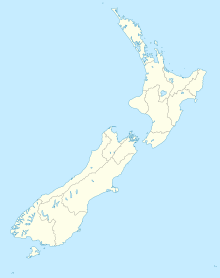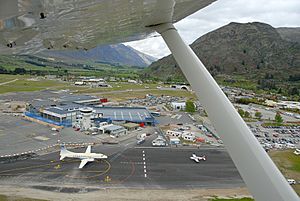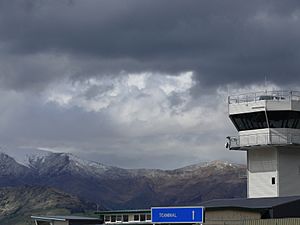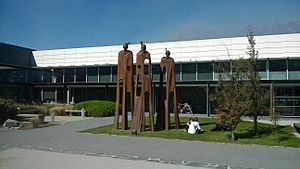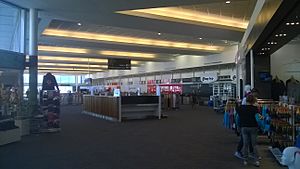Queenstown Airport facts for kids
Quick facts for kids
Queenstown Airport
|
|||||||||||||||
|---|---|---|---|---|---|---|---|---|---|---|---|---|---|---|---|
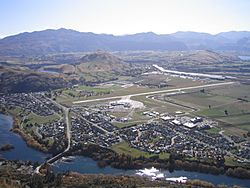 |
|||||||||||||||
| Summary | |||||||||||||||
| Airport type | Public | ||||||||||||||
| Owner | Auckland Airport Corp, Queenstown Lakes District Council, Shareholders | ||||||||||||||
| Operator | Queenstown Airport Corporation Ltd. | ||||||||||||||
| Serves | Queenstown, Arrowtown | ||||||||||||||
| Location | Queenstown, New Zealand | ||||||||||||||
| Elevation AMSL | 357 m / 1,171 ft | ||||||||||||||
| Coordinates | 45°01′16″S 168°44′21″E / 45.02111°S 168.73917°E | ||||||||||||||
| Website | queenstownairport.co.nz | ||||||||||||||
| Map | |||||||||||||||
| Runway | |||||||||||||||
|
|||||||||||||||
| Statistics (July 2017 to June 2018) | |||||||||||||||
|
|||||||||||||||
|
Source:
|
|||||||||||||||
Queenstown Airport (IATA: ZQN, ICAO: NZQN) is a busy airport in Frankton, Otago, New Zealand. It serves the popular tourist town of Queenstown. The airport is about 8 kilometers (5 miles) from Queenstown's main town center. In 2018, over 2.25 million people traveled through Queenstown Airport. This makes it the fourth busiest airport in New Zealand. The airport has two runways and one main building for passengers.
Contents
History of Queenstown Airport
Queenstown Airport first got its license to operate in 1935. But it wasn't until the 1950s that many commercial flights started. These early flights often took tourists on "flightseeing" trips to places like Milford Sound. On July 17, 1950, a regular scenic route began between Queenstown and Dunedin. Mount Cook Airline was a key company that started tourist flights here.
In the 1960s, the airport's grass runway was made longer. Regular flights from Christchurch began on November 6, 1961. These flights used DC-3 planes and flew three times a week. Later, in 1968, HS-748 aircraft were used, which could carry more passengers.
The Britten Norman Islander plane became very important for flights to Milford Sound, starting in 1970. These planes were also used for trips to Te Anau and Dunedin.
In 1989, Ansett New Zealand started the first jet flights into Queenstown Airport. Air New Zealand followed in 1992 with Boeing 737-200 planes.
International Flights Begin
In 1995, Air New Zealand made history by landing Queenstown Airport's first international flight from Sydney, Australia. More international flights quickly followed, especially bringing skiers during winter. Since then, the airport has grown a lot to handle more passengers and flights.
A big step forward happened in 2004 when Qantas started using special technology called RNP AR. This technology helps planes land very accurately, even in difficult weather. This made flights much more reliable for the local community and visitors.
Since then, the number of passengers has grown a lot. Queenstown Airport is now one of New Zealand's busiest and fastest-growing airports. It's a direct way for people to get to the lower South Island. The airport even won an award in 2015 for the 'World’s Most Scenic Airport Landing'.
Evening Flights
In 2012, new flight procedures were introduced that allowed jet planes to fly very precise paths. This technology helped the airport prepare for flights after dark.
In May 2014, authorities in New Zealand and Australia approved Queenstown Airport for after-dark flights. This approval depended on the airport adding more equipment and technology.
In June 2015, the airport opened its new international terminal. It also started plans to have evening flights by winter 2016. Evening flights allow the airport to handle more planes without building a lot more buildings right away. This means more travel options for people and more jobs for the community.
Airport Building
Queenstown Airport has one main building, called a terminal. This terminal handles both flights within New Zealand and international flights to other countries. It has been made bigger many times since the 1990s. This was needed because more international flights started and the number of passengers grew quickly.
The terminal has one level. Planes do not connect directly to the building with special bridges. This means passengers walk across the outdoor area to get to and from their planes. In 2015, the international area was expanded. A second level was added, which could allow for special bridges in the future.
Airport Operations
Many airlines fly to and from Queenstown. For flights within New Zealand, Air New Zealand connects Queenstown with Auckland, Wellington, and Christchurch. Jetstar Airways also flies to Auckland and Wellington.
International flights have increased a lot recently. Flights now go all year round to Sydney, Melbourne, Brisbane, and the Gold Coast in Australia. Four airlines fly these routes: Air New Zealand, Jetstar Airways, Qantas, and Virgin Australia. During the busy winter season, there are often more than 59 direct flights from Australia each week.
Queenstown Airport is also very popular for tourist "flightseeing" trips. Many small planes and helicopters fly from here to places like Milford Sound and Aoraki Mount Cook. It is New Zealand's busiest helicopter airport. Private jets are also using the airport more, with planes flying directly from places like North Asia and the United States.
Airlines and Destinations
| Airlines | Destinations |
|---|---|
| Air Milford | Milford Sound, Te Anau |
| Air New Zealand | Auckland, Brisbane, Christchurch, Melbourne, Sydney, Wellington |
| Glenorchy Air | Milford Sound, Stewart Island |
| Jetstar | Auckland, Gold Coast, Melbourne, Sydney, Wellington |
| Qantas | Sydney Seasonal: Brisbane, Melbourne |
| Virgin Australia | Brisbane, Melbourne, Sydney |
Airport Statistics
| Rank | Airport | Passengers | Annual change | Carriers |
|---|---|---|---|---|
| 1 | Sydney | 315,596 | Air New Zealand, Jetstar, Qantas, Virgin Australia | |
| 2 | Melbourne | 142,025 | Air New Zealand, Jetstar, Virgin Australia | |
| 3 | Brisbane | 75,856 | Qantas, Virgin Australia | |
| 4 | Gold Coast | 47,098 | Jetstar |
Airport Upgrades
In July 2011, new runway lights were turned on for the first time. These lights help planes land safely even when it's hard to see. This was a big improvement for the airport. The project cost $2 million and included many new lights and cables. Before this, planes could only fly during daylight hours.
In April 2012, Queenstown Airport opened a new paved runway. This runway helps when there are strong cross-winds. Paving it made flights safer and reduced delays.
New International Terminal
After announcing plans in 2010, work began in 2014 on a new international terminal. This new part of the airport opened on June 23, 2015. It cost $17 million and made the international area twice as big. It has new facilities, including two new gate lounges with amazing views of the mountains. There's also a new duty-free shop, a modern customs area, and more shops. The new terminal also has a second level, ready for future additions like jet bridges.
In November 2015, the airport started another $17 million project. This project improved the airfield to allow for evening flights starting in winter 2016. These changes also made operations safer and more efficient.
Partnership with Auckland Airport
On July 8, 2010, Auckland International Airport Limited, which runs Auckland Airport, announced a partnership. They bought a share in Queenstown Airport Corporation Limited. This partnership was expected to bring an extra 176,000 passengers through Queenstown Airport.
Auckland Airport has the option to increase its share in Queenstown Airport in the future. This new money helps Queenstown Airport grow and improve its services. It also means regular payments can go back to the community through the Queenstown Lakes District Council.


